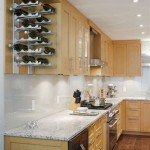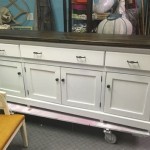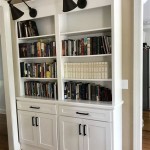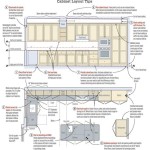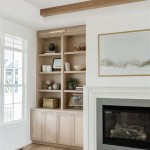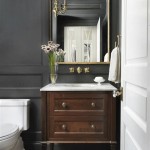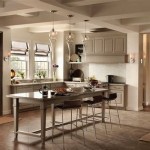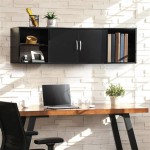Optimizing Your Kitchen With Range Hood Under Cabinets
The modern kitchen is a multi-functional space, acting as a hub for culinary creativity, family gatherings, and social interactions. Maintaining a clean, comfortable, and efficient kitchen environment is paramount to its overall functionality. A crucial component in achieving this is the range hood, specifically an under-cabinet range hood. This article explores the advantages, considerations, and best practices associated with integrating an under-cabinet range hood into your kitchen design.
Range hoods serve a vital purpose by removing smoke, grease, heat, and odors generated during cooking. Without proper ventilation, these pollutants can accumulate in the kitchen, leading to poor air quality, greasy surfaces, and lingering smells. Under-cabinet range hoods offer a practical and space-saving solution for homes with limited kitchen space or existing cabinetry. They are designed to be installed directly beneath the upper cabinets, seamlessly integrating into the kitchen’s overall aesthetic.
Understanding the Benefits of Under-Cabinet Range Hoods
Under-cabinet range hoods offer several key advantages that make them a popular choice for homeowners. Their compact design, ease of installation, and effective ventilation capabilities contribute to a more comfortable and efficient kitchen environment.
Firstly, space optimization is a significant benefit. In kitchens where space is at a premium, an under-cabinet range hood provides a powerful ventilation solution without sacrificing valuable cabinet space. These hoods are designed to fit snugly beneath existing cabinets, maximizing vertical space utilization. This is particularly beneficial in smaller kitchens or apartments where every inch counts.
Secondly, the ease of installation is appealing to many homeowners. Under-cabinet range hoods are generally simpler to install compared to other types of range hoods, such as chimney-style or island hoods. Many models come with detailed installation instructions and mounting hardware, allowing for a relatively straightforward installation process. Some homeowners may even be able to install the hood themselves, saving on professional installation costs. However, it's crucial to consult a qualified electrician for any electrical wiring to ensure safety and compliance with local codes.
Thirdly, cost-effectiveness is a notable attribute. Under-cabinet range hoods are typically more affordable than other types of range hoods. This makes them an attractive option for homeowners on a budget who are still seeking effective kitchen ventilation. The lower initial cost, combined with the potential for self-installation, can result in significant savings compared to more elaborate range hood systems.
Finally, improved air quality contributes to healthier living. By effectively removing smoke, grease, and odors, under-cabinet range hoods help maintain a cleaner and healthier kitchen environment. This is especially important for individuals with respiratory sensitivities or allergies. A well-ventilated kitchen reduces the build-up of airborne pollutants, promoting better overall air quality and reducing the risk of respiratory problems.
Key Considerations When Selecting an Under-Cabinet Range Hood
Choosing the right under-cabinet range hood involves careful consideration of several factors, including size, ventilation power, noise level, and design. Making an informed decision ensures that the selected hood meets your specific needs and complements your kitchen's aesthetic.
The size of the range hood is paramount. The width of the range hood should be at least equal to the width of the cooktop or range. Ideally, it should be slightly wider to effectively capture smoke and grease. This ensures that all cooking surfaces are adequately covered by the ventilation system. A hood that is too small will not effectively capture pollutants, rendering it less effective.
Ventilation power, measured in cubic feet per minute (CFM), is a crucial specification. The appropriate CFM rating depends on the type of cooking you typically do and the size of your kitchen. For gas cooktops, a higher CFM rating is generally recommended due to the increased heat and combustion byproducts. A general rule of thumb is to have at least 100 CFM per linear foot of cooktop width. For example, a 30-inch cooktop would require a minimum of 250 CFM. Consider the height of your ceilings as well when calculating the appropriate CFM as taller ceilings require greater ventilation power. The CFM rating dictates how effectively the hood removes pollutants from the air.
Noise level is an important consideration, especially for open-concept kitchens. Range hoods can produce varying levels of noise, measured in sones. A lower sone rating indicates a quieter operation. Consider the noise level at different fan speeds to ensure it doesn't disrupt conversation or create an unpleasant kitchen environment. Look for models with noise reduction technology or variable speed settings that allow you to adjust the fan speed and noise level as needed.
The design and finish should complement your kitchen decor. Under-cabinet range hoods are available in a variety of styles and finishes, including stainless steel, black, white, and copper. Choose a finish that matches your existing appliances and cabinetry to create a cohesive look. Consider the overall aesthetic of your kitchen and select a hood that enhances the design. Some models also feature integrated lighting to illuminate the cooking surface, further enhancing functionality and aesthetics.
Furthermore, ducting options play a significant role in performance. Range hoods can be either ducted or ductless. Ducted range hoods vent air outside, providing the most effective ventilation. Ductless range hoods recirculate air through filters, which need to be cleaned or replaced regularly. If possible, opt for a ducted range hood to ensure optimal ventilation. Ductless hoods are a suitable alternative when ducting to the outside is not feasible, but they are generally less effective at removing pollutants.
Finally, maintenance and cleaning requirements should be factored into a decision. Regular cleaning of the range hood filters is essential to maintain its performance and prevent grease buildup. Look for models with dishwasher-safe filters for easy cleaning. Consider the accessibility of the filters and the ease of removing and replacing them. Proper maintenance ensures that the range hood continues to operate efficiently and effectively over time.
Installation and Maintenance Best Practices
Proper installation and regular maintenance are crucial for ensuring the optimal performance and longevity of an under-cabinet range hood. Following best practices for both installation and maintenance will maximize the benefits of your ventilation system.
For installation, accurate measurements are imperative. Before installing the range hood, carefully measure the space beneath the cabinets to ensure a proper fit. Confirm that there is adequate clearance between the cooktop and the bottom of the range hood, typically recommended to be between 24 and 30 inches. Accurate measurements prevent installation errors and ensure that the hood functions properly.
Professional electrical connection is highly recommended. Wiring the range hood to the electrical system should be performed by a qualified electrician to ensure safety and compliance with local electrical codes. Incorrect wiring can pose a fire hazard or damage the appliance. A professional electrician will ensure that the wiring is properly grounded and that the correct voltage is used.
Proper ductwork installation is vital for ducted range hoods. The ductwork should be properly sized and installed to maximize airflow and prevent backdrafting. Use smooth, rigid ductwork whenever possible, as it offers better airflow than flexible ductwork. Ensure that the ductwork is properly sealed to prevent air leaks. Incorrect ductwork installation can significantly reduce the effectiveness of the range hood.
Regular filter cleaning or replacement is essential for maintaining optimal performance. Clean or replace the range hood filters regularly, depending on the type of filter and the frequency of cooking. Grease filters should be cleaned at least once a month, while charcoal filters should be replaced every three to six months. Clean filters allow for better airflow and prevent grease buildup, which can reduce the hood's effectiveness and pose a fire hazard.
Surface cleaning is also crucial. Regularly clean the exterior surfaces of the range hood to remove grease and grime. Use a mild detergent and a soft cloth to avoid scratching the finish. Wipe down the surfaces after each use to prevent buildup. Regular cleaning helps maintain the hood's appearance and prevents the accumulation of grease, which can be difficult to remove over time.
Addressing any issues promptly is important. If you notice any problems with the range hood, such as unusual noises, reduced airflow, or malfunctioning lights, address them promptly. Consult the owner's manual or contact a qualified appliance repair technician for assistance. Ignoring minor issues can lead to more serious problems and costly repairs in the future.
By adhering to these installation and maintenance best practices, homeowners can maximize the performance, longevity, and safety of their under-cabinet range hood, ensuring a clean, comfortable, and efficient kitchen environment.

Kitchen Range Hood Ideas The Ultimate Guide

Kitchen Range Hood Ideas The Ultimate Guide

Choosing The Perfect Range Hood Everything You Need To Know

Types Of Range Hoods Under Cabinet Island Mounted More

Kitchen Range Hood Ideas The Ultimate Guide

Range Hood Insert Buyer S Guide

Kitchen Range Hood Ideas The Ultimate Guide

Why Hiding Your Stove Range Hood Is All The Rage This Year

Four Components Of Kitchen Exhaust Systems Greenbuildingadvisor

Streamline 30 In Domenico Ducted Under Cabinet Range Hood Grit Black With Mesh Filters Push On Control Led Light T 3208 4 Dt The Home Depot
Related Posts

